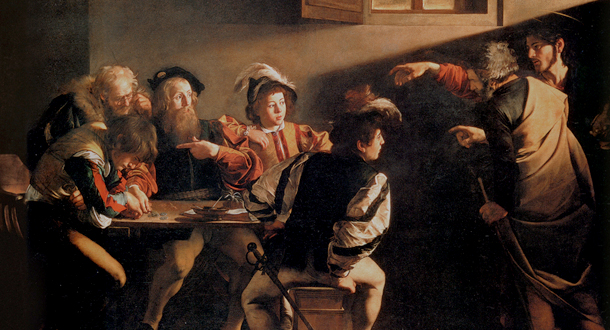
Feast of St. Matthew, Apostle
Scripture:
Ephesians 4:1-7, 11-13
Matthew 9: 9-13
Reflection:
He said to him, “Follow me.” And he got up and followed him. -Matthew 9:9
The Calling of Saint Matthew is a painting completed in 1599-1600 by the famous Italian painter Michelangelo Merisi da Caravaggio and illustrates when Jesus went into the custom house, saw Matthew the tax collector at his seat and called to him, “Follow me”. According to the gospel story Matthew rose and followed him. In the painting, Christ (on the right, behind Peter) points to Levi, the tax-collector (the bearded man wearing a beret and calls upon him to become the apostle, Matthew.
We can learn a lot from this painting. To begin with, when Matthew sees Christ pointing at him, Levi responds with a gesture, as if to say “Me?” indicating his uncertainty whether he is being addressed, or the younger man slumped on his right. Through the visual contrast between their reactions, Caravaggio displays psychological insight into two possible patterns of human behavior in the same situation of being called. (Famous Paintings: Analysis and Interpretation)
When God is calling us, do we respond “who me?” “You’ve got to be kidding.” “You can’t possibly want me.” Caravaggio shows us that miracles occur in the midst of our being called in the most mundane situations. In its capture of the exact split-second when Christ’s summons hangs in the air, and his listeners are still shocked and Levi himself is caught in suspended indecision. In another second, he will rise up, become Matthew the apostle and follow Christ out of the room. ((Famous Paintings: Analysis and Interpretation)
Prayer:
Lord, we are humbled that You call us as you called St. Matthew to serve, in ways big and small, to accomplish Your will here on earth. Help us respond without hesitation whenever we perceive Your voice calling us into action. In Your powerful and equipping Name, we pray, Amen.
Carl Middleton is a theologian/ethicist and a member of the Passionist Family.
